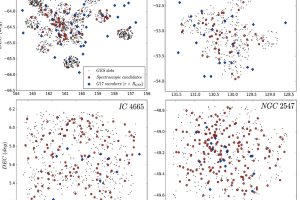The Gaia-ESO survey and the evolution of stellar clusters. Published on A&A “The Gaia-ESO Survey: kinematical and dynamical study of four young open clusters” of L. Bravi (INAF-OA Arcetri)

Despite the stars in our Galaxy typically formed in stellar clusters, only a small fraction of them today is observed associated with a cluster. This led to the conclusion that stellar clusters typically disperse in 10-100 million years. Two mechanisms are thought to be responsible for the dispersion of stellar clusters. According to the model of the “residual gas expulsion”, stellar cluster disperse after the gas that did not formed stars is dissipated by the radiation from the massive stars (Kroupa et al. 2001). It has also been suggested that clusters are dispersed by the gravitational interaction among stars in their most dense regions (Parker & Wright 2016).
In order to discriminate among the two scenarios, it is necessary to measure the velocity dispersion of suitable stellar clusters. In fact, the “residual gas expulsion” scenario predicts that after the dispersion of the intracluster gas, typically occurring in less than 10 million years, the dispersion velocity becomes “supervirial” (e.g. larger than the velocity predicted by the viral theorem, which relates the time averaged kinetic energy with the potential energy in a system in equilibrium). This diagnostic requires the measurement of stellar radial velocity from high-resolution spectra in order to calculate the cluster velocity dispersion, and the estimate of the viral velocity from the total mass of the cluster and its morphology.
Such accurate measurements are possible today thanks to the high-resolution spectroscopic observations of stellar clusters from the Gaia-ESO Survey. The international team of researchers led by L. Bravi, of INAF-Astronomical Observatory of Arcetri and the Physic Department of the University of Florence, has analysed the data from the Gaia-ESO Survey of the stellar clusters IC 2602, IC 2391, IC 4665, and NGC 2547, which are 20-50 million years old, in order to understand which is the leading dispersion mechanism. The authors have measured their dispersion velocity from the individual radial velocity of the stars associated with these stellar clusters. They have then calculated the viral velocity after estimating the total cluster mass and have analysed their morphology. The result is that in three cases (IC 2602, IC 2391 e NGC 2547), the dispersion velocity is about twice the virial velocity. Results for IC 4665 are not conclusive. This finding support the “residual gas expulsion” for these clusters, even if it is also possible that stars have not reached their dynamical equilibrium despite the age of these clusters. The paper “The Gaia-ESO Survey: a kinematical and dynamical study of four young open clusters” describing this research has been published by Astronomy & Astrophysics with the collaboration of E. Flaccomio, F. Damiani, and L. Prisinzano of INAF – Astronomical Observatory of Palermo.
The figure (link) shows the spatial distribution of the stars associated with the four clusters studied in this paper.
